BO1BLAW204 Business Law: Analyzing a Negligence & Defenses Case
VerifiedAdded on 2023/06/07
|6
|2159
|53
Case Study
AI Summary
This case study examines a negligence claim against Susan, the owner of a Bengal tiger named Benji, following an incident where Benji escaped and caused damages to Cliff and Mary. The analysis focuses on whether Susan owed a duty of care to Cliff and Mary, whether that duty was breached, and whether the damages suffered were a direct result of the breach. The study applies relevant legal principles from Donoghue v. Stevenson and other case laws to determine Susan's liability. It also explores potential defenses, such as remoteness of damage, and concludes that while Susan may be liable for the mental shock suffered by Cliff and Mary, she is unlikely to be held responsible for the property damage due to remoteness. Desklib offers similar case studies and resources for business law students.
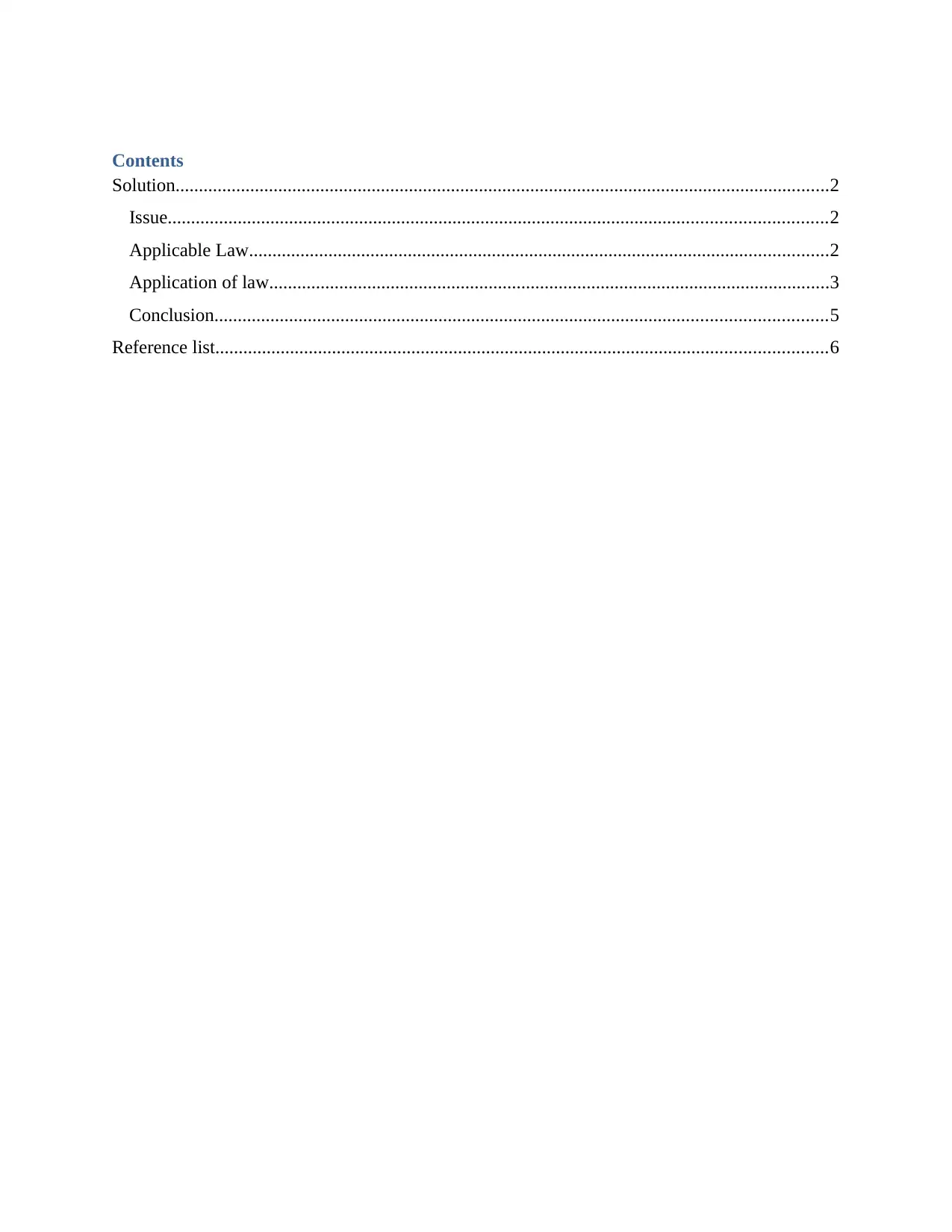
Contents
Solution............................................................................................................................................2
Issue.............................................................................................................................................2
Applicable Law............................................................................................................................2
Application of law........................................................................................................................3
Conclusion...................................................................................................................................5
Reference list...................................................................................................................................6
Solution............................................................................................................................................2
Issue.............................................................................................................................................2
Applicable Law............................................................................................................................2
Application of law........................................................................................................................3
Conclusion...................................................................................................................................5
Reference list...................................................................................................................................6
Paraphrase This Document
Need a fresh take? Get an instant paraphrase of this document with our AI Paraphraser
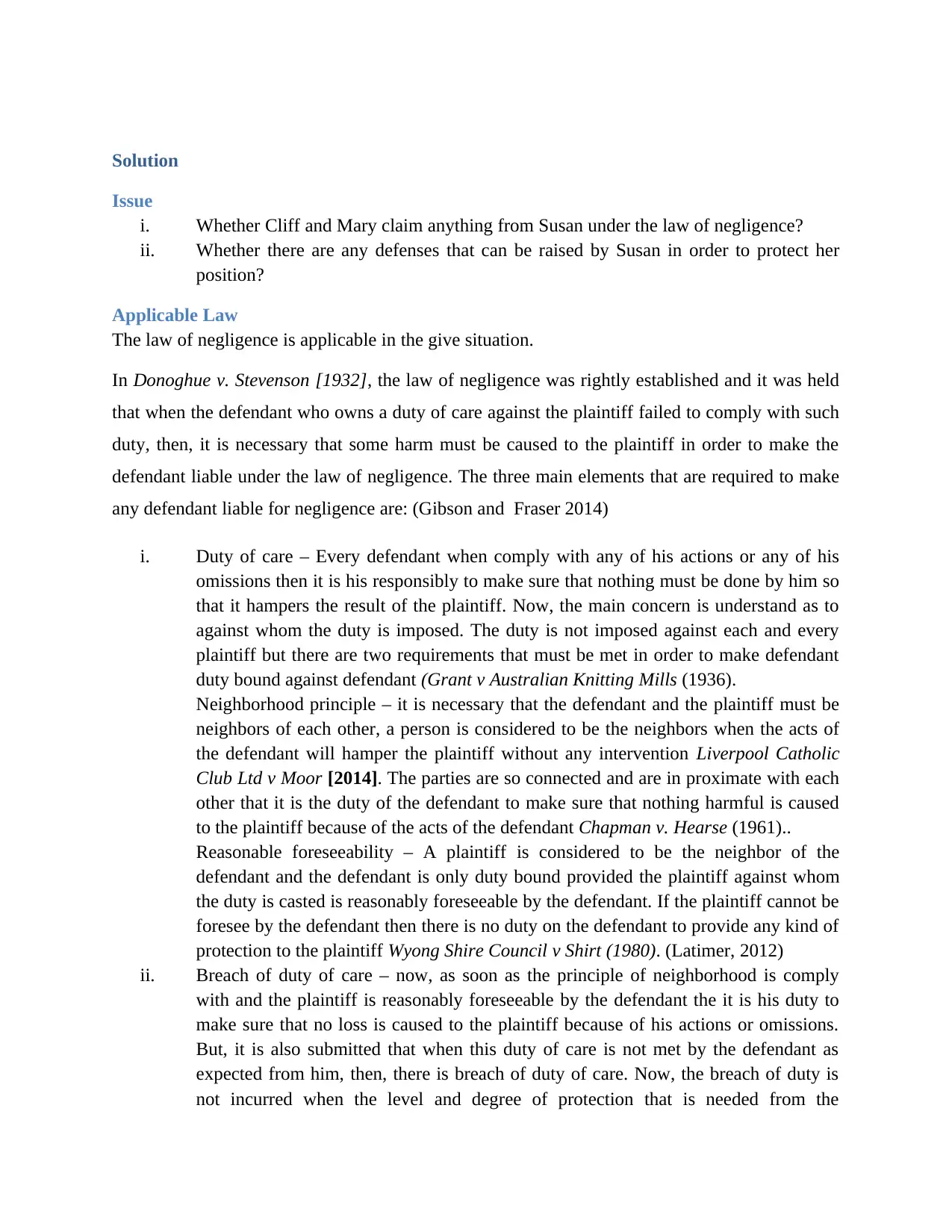
Solution
Issue
i. Whether Cliff and Mary claim anything from Susan under the law of negligence?
ii. Whether there are any defenses that can be raised by Susan in order to protect her
position?
Applicable Law
The law of negligence is applicable in the give situation.
In Donoghue v. Stevenson [1932], the law of negligence was rightly established and it was held
that when the defendant who owns a duty of care against the plaintiff failed to comply with such
duty, then, it is necessary that some harm must be caused to the plaintiff in order to make the
defendant liable under the law of negligence. The three main elements that are required to make
any defendant liable for negligence are: (Gibson and Fraser 2014)
i. Duty of care – Every defendant when comply with any of his actions or any of his
omissions then it is his responsibly to make sure that nothing must be done by him so
that it hampers the result of the plaintiff. Now, the main concern is understand as to
against whom the duty is imposed. The duty is not imposed against each and every
plaintiff but there are two requirements that must be met in order to make defendant
duty bound against defendant (Grant v Australian Knitting Mills (1936).
Neighborhood principle – it is necessary that the defendant and the plaintiff must be
neighbors of each other, a person is considered to be the neighbors when the acts of
the defendant will hamper the plaintiff without any intervention Liverpool Catholic
Club Ltd v Moor [2014]. The parties are so connected and are in proximate with each
other that it is the duty of the defendant to make sure that nothing harmful is caused
to the plaintiff because of the acts of the defendant Chapman v. Hearse (1961)..
Reasonable foreseeability – A plaintiff is considered to be the neighbor of the
defendant and the defendant is only duty bound provided the plaintiff against whom
the duty is casted is reasonably foreseeable by the defendant. If the plaintiff cannot be
foresee by the defendant then there is no duty on the defendant to provide any kind of
protection to the plaintiff Wyong Shire Council v Shirt (1980). (Latimer, 2012)
ii. Breach of duty of care – now, as soon as the principle of neighborhood is comply
with and the plaintiff is reasonably foreseeable by the defendant the it is his duty to
make sure that no loss is caused to the plaintiff because of his actions or omissions.
But, it is also submitted that when this duty of care is not met by the defendant as
expected from him, then, there is breach of duty of care. Now, the breach of duty is
not incurred when the level and degree of protection that is needed from the
Issue
i. Whether Cliff and Mary claim anything from Susan under the law of negligence?
ii. Whether there are any defenses that can be raised by Susan in order to protect her
position?
Applicable Law
The law of negligence is applicable in the give situation.
In Donoghue v. Stevenson [1932], the law of negligence was rightly established and it was held
that when the defendant who owns a duty of care against the plaintiff failed to comply with such
duty, then, it is necessary that some harm must be caused to the plaintiff in order to make the
defendant liable under the law of negligence. The three main elements that are required to make
any defendant liable for negligence are: (Gibson and Fraser 2014)
i. Duty of care – Every defendant when comply with any of his actions or any of his
omissions then it is his responsibly to make sure that nothing must be done by him so
that it hampers the result of the plaintiff. Now, the main concern is understand as to
against whom the duty is imposed. The duty is not imposed against each and every
plaintiff but there are two requirements that must be met in order to make defendant
duty bound against defendant (Grant v Australian Knitting Mills (1936).
Neighborhood principle – it is necessary that the defendant and the plaintiff must be
neighbors of each other, a person is considered to be the neighbors when the acts of
the defendant will hamper the plaintiff without any intervention Liverpool Catholic
Club Ltd v Moor [2014]. The parties are so connected and are in proximate with each
other that it is the duty of the defendant to make sure that nothing harmful is caused
to the plaintiff because of the acts of the defendant Chapman v. Hearse (1961)..
Reasonable foreseeability – A plaintiff is considered to be the neighbor of the
defendant and the defendant is only duty bound provided the plaintiff against whom
the duty is casted is reasonably foreseeable by the defendant. If the plaintiff cannot be
foresee by the defendant then there is no duty on the defendant to provide any kind of
protection to the plaintiff Wyong Shire Council v Shirt (1980). (Latimer, 2012)
ii. Breach of duty of care – now, as soon as the principle of neighborhood is comply
with and the plaintiff is reasonably foreseeable by the defendant the it is his duty to
make sure that no loss is caused to the plaintiff because of his actions or omissions.
But, it is also submitted that when this duty of care is not met by the defendant as
expected from him, then, there is breach of duty of care. Now, the breach of duty is
not incurred when the level and degree of protection that is needed from the
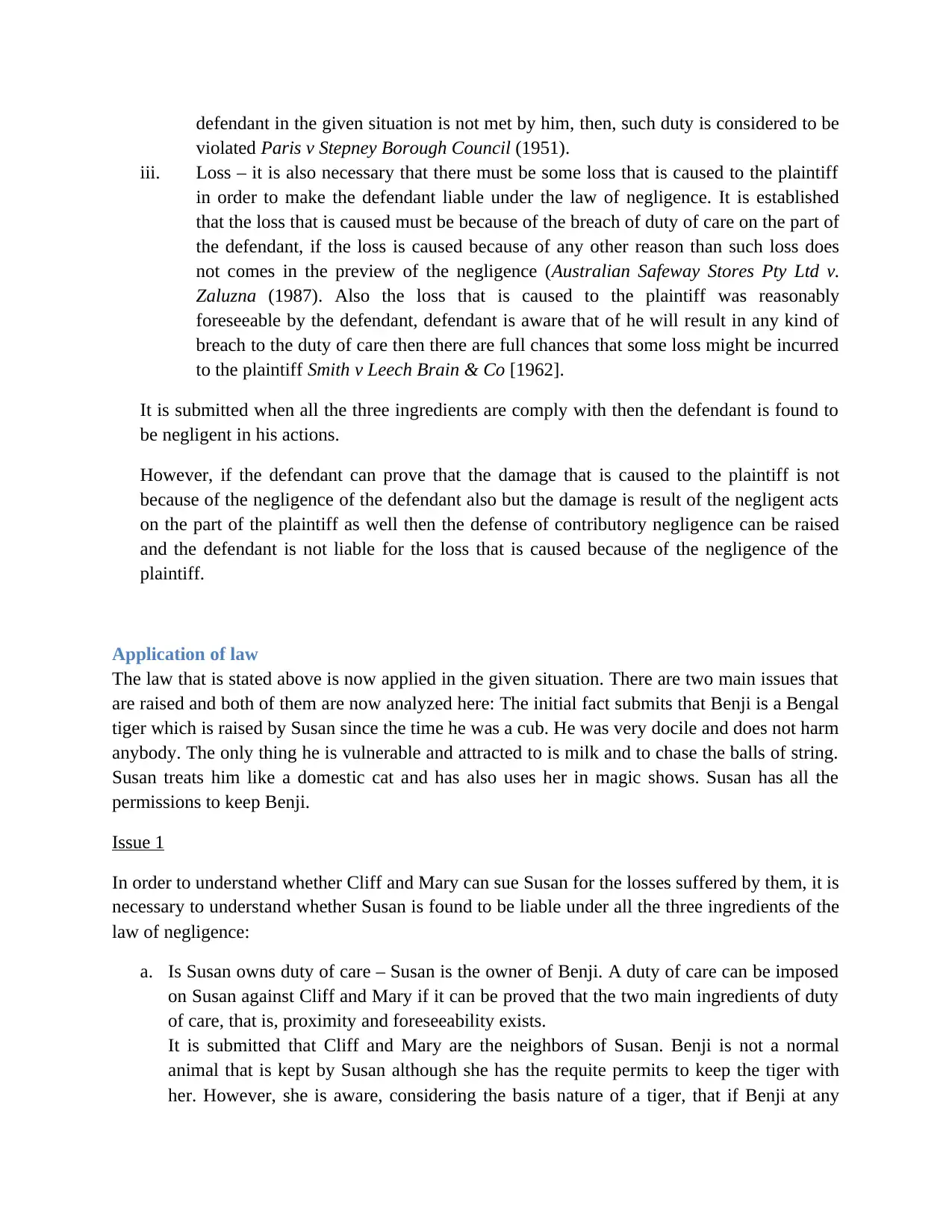
defendant in the given situation is not met by him, then, such duty is considered to be
violated Paris v Stepney Borough Council (1951).
iii. Loss – it is also necessary that there must be some loss that is caused to the plaintiff
in order to make the defendant liable under the law of negligence. It is established
that the loss that is caused must be because of the breach of duty of care on the part of
the defendant, if the loss is caused because of any other reason than such loss does
not comes in the preview of the negligence (Australian Safeway Stores Pty Ltd v.
Zaluzna (1987). Also the loss that is caused to the plaintiff was reasonably
foreseeable by the defendant, defendant is aware that of he will result in any kind of
breach to the duty of care then there are full chances that some loss might be incurred
to the plaintiff Smith v Leech Brain & Co [1962].
It is submitted when all the three ingredients are comply with then the defendant is found to
be negligent in his actions.
However, if the defendant can prove that the damage that is caused to the plaintiff is not
because of the negligence of the defendant also but the damage is result of the negligent acts
on the part of the plaintiff as well then the defense of contributory negligence can be raised
and the defendant is not liable for the loss that is caused because of the negligence of the
plaintiff.
Application of law
The law that is stated above is now applied in the given situation. There are two main issues that
are raised and both of them are now analyzed here: The initial fact submits that Benji is a Bengal
tiger which is raised by Susan since the time he was a cub. He was very docile and does not harm
anybody. The only thing he is vulnerable and attracted to is milk and to chase the balls of string.
Susan treats him like a domestic cat and has also uses her in magic shows. Susan has all the
permissions to keep Benji.
Issue 1
In order to understand whether Cliff and Mary can sue Susan for the losses suffered by them, it is
necessary to understand whether Susan is found to be liable under all the three ingredients of the
law of negligence:
a. Is Susan owns duty of care – Susan is the owner of Benji. A duty of care can be imposed
on Susan against Cliff and Mary if it can be proved that the two main ingredients of duty
of care, that is, proximity and foreseeability exists.
It is submitted that Cliff and Mary are the neighbors of Susan. Benji is not a normal
animal that is kept by Susan although she has the requite permits to keep the tiger with
her. However, she is aware, considering the basis nature of a tiger, that if Benji at any
violated Paris v Stepney Borough Council (1951).
iii. Loss – it is also necessary that there must be some loss that is caused to the plaintiff
in order to make the defendant liable under the law of negligence. It is established
that the loss that is caused must be because of the breach of duty of care on the part of
the defendant, if the loss is caused because of any other reason than such loss does
not comes in the preview of the negligence (Australian Safeway Stores Pty Ltd v.
Zaluzna (1987). Also the loss that is caused to the plaintiff was reasonably
foreseeable by the defendant, defendant is aware that of he will result in any kind of
breach to the duty of care then there are full chances that some loss might be incurred
to the plaintiff Smith v Leech Brain & Co [1962].
It is submitted when all the three ingredients are comply with then the defendant is found to
be negligent in his actions.
However, if the defendant can prove that the damage that is caused to the plaintiff is not
because of the negligence of the defendant also but the damage is result of the negligent acts
on the part of the plaintiff as well then the defense of contributory negligence can be raised
and the defendant is not liable for the loss that is caused because of the negligence of the
plaintiff.
Application of law
The law that is stated above is now applied in the given situation. There are two main issues that
are raised and both of them are now analyzed here: The initial fact submits that Benji is a Bengal
tiger which is raised by Susan since the time he was a cub. He was very docile and does not harm
anybody. The only thing he is vulnerable and attracted to is milk and to chase the balls of string.
Susan treats him like a domestic cat and has also uses her in magic shows. Susan has all the
permissions to keep Benji.
Issue 1
In order to understand whether Cliff and Mary can sue Susan for the losses suffered by them, it is
necessary to understand whether Susan is found to be liable under all the three ingredients of the
law of negligence:
a. Is Susan owns duty of care – Susan is the owner of Benji. A duty of care can be imposed
on Susan against Cliff and Mary if it can be proved that the two main ingredients of duty
of care, that is, proximity and foreseeability exists.
It is submitted that Cliff and Mary are the neighbors of Susan. Benji is not a normal
animal that is kept by Susan although she has the requite permits to keep the tiger with
her. However, she is aware, considering the basis nature of a tiger, that if Benji at any
⊘ This is a preview!⊘
Do you want full access?
Subscribe today to unlock all pages.

Trusted by 1+ million students worldwide
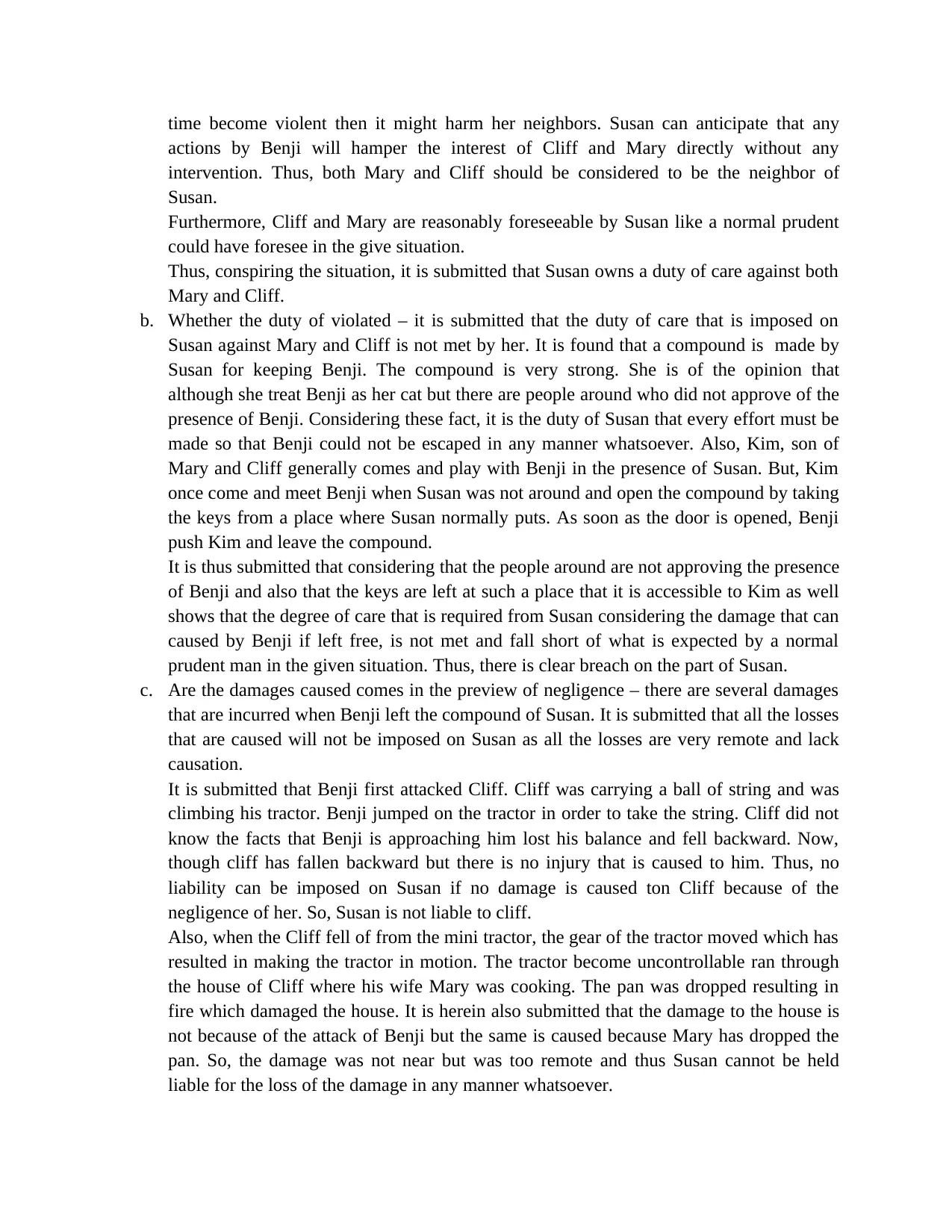
time become violent then it might harm her neighbors. Susan can anticipate that any
actions by Benji will hamper the interest of Cliff and Mary directly without any
intervention. Thus, both Mary and Cliff should be considered to be the neighbor of
Susan.
Furthermore, Cliff and Mary are reasonably foreseeable by Susan like a normal prudent
could have foresee in the give situation.
Thus, conspiring the situation, it is submitted that Susan owns a duty of care against both
Mary and Cliff.
b. Whether the duty of violated – it is submitted that the duty of care that is imposed on
Susan against Mary and Cliff is not met by her. It is found that a compound is made by
Susan for keeping Benji. The compound is very strong. She is of the opinion that
although she treat Benji as her cat but there are people around who did not approve of the
presence of Benji. Considering these fact, it is the duty of Susan that every effort must be
made so that Benji could not be escaped in any manner whatsoever. Also, Kim, son of
Mary and Cliff generally comes and play with Benji in the presence of Susan. But, Kim
once come and meet Benji when Susan was not around and open the compound by taking
the keys from a place where Susan normally puts. As soon as the door is opened, Benji
push Kim and leave the compound.
It is thus submitted that considering that the people around are not approving the presence
of Benji and also that the keys are left at such a place that it is accessible to Kim as well
shows that the degree of care that is required from Susan considering the damage that can
caused by Benji if left free, is not met and fall short of what is expected by a normal
prudent man in the given situation. Thus, there is clear breach on the part of Susan.
c. Are the damages caused comes in the preview of negligence – there are several damages
that are incurred when Benji left the compound of Susan. It is submitted that all the losses
that are caused will not be imposed on Susan as all the losses are very remote and lack
causation.
It is submitted that Benji first attacked Cliff. Cliff was carrying a ball of string and was
climbing his tractor. Benji jumped on the tractor in order to take the string. Cliff did not
know the facts that Benji is approaching him lost his balance and fell backward. Now,
though cliff has fallen backward but there is no injury that is caused to him. Thus, no
liability can be imposed on Susan if no damage is caused ton Cliff because of the
negligence of her. So, Susan is not liable to cliff.
Also, when the Cliff fell of from the mini tractor, the gear of the tractor moved which has
resulted in making the tractor in motion. The tractor become uncontrollable ran through
the house of Cliff where his wife Mary was cooking. The pan was dropped resulting in
fire which damaged the house. It is herein also submitted that the damage to the house is
not because of the attack of Benji but the same is caused because Mary has dropped the
pan. So, the damage was not near but was too remote and thus Susan cannot be held
liable for the loss of the damage in any manner whatsoever.
actions by Benji will hamper the interest of Cliff and Mary directly without any
intervention. Thus, both Mary and Cliff should be considered to be the neighbor of
Susan.
Furthermore, Cliff and Mary are reasonably foreseeable by Susan like a normal prudent
could have foresee in the give situation.
Thus, conspiring the situation, it is submitted that Susan owns a duty of care against both
Mary and Cliff.
b. Whether the duty of violated – it is submitted that the duty of care that is imposed on
Susan against Mary and Cliff is not met by her. It is found that a compound is made by
Susan for keeping Benji. The compound is very strong. She is of the opinion that
although she treat Benji as her cat but there are people around who did not approve of the
presence of Benji. Considering these fact, it is the duty of Susan that every effort must be
made so that Benji could not be escaped in any manner whatsoever. Also, Kim, son of
Mary and Cliff generally comes and play with Benji in the presence of Susan. But, Kim
once come and meet Benji when Susan was not around and open the compound by taking
the keys from a place where Susan normally puts. As soon as the door is opened, Benji
push Kim and leave the compound.
It is thus submitted that considering that the people around are not approving the presence
of Benji and also that the keys are left at such a place that it is accessible to Kim as well
shows that the degree of care that is required from Susan considering the damage that can
caused by Benji if left free, is not met and fall short of what is expected by a normal
prudent man in the given situation. Thus, there is clear breach on the part of Susan.
c. Are the damages caused comes in the preview of negligence – there are several damages
that are incurred when Benji left the compound of Susan. It is submitted that all the losses
that are caused will not be imposed on Susan as all the losses are very remote and lack
causation.
It is submitted that Benji first attacked Cliff. Cliff was carrying a ball of string and was
climbing his tractor. Benji jumped on the tractor in order to take the string. Cliff did not
know the facts that Benji is approaching him lost his balance and fell backward. Now,
though cliff has fallen backward but there is no injury that is caused to him. Thus, no
liability can be imposed on Susan if no damage is caused ton Cliff because of the
negligence of her. So, Susan is not liable to cliff.
Also, when the Cliff fell of from the mini tractor, the gear of the tractor moved which has
resulted in making the tractor in motion. The tractor become uncontrollable ran through
the house of Cliff where his wife Mary was cooking. The pan was dropped resulting in
fire which damaged the house. It is herein also submitted that the damage to the house is
not because of the attack of Benji but the same is caused because Mary has dropped the
pan. So, the damage was not near but was too remote and thus Susan cannot be held
liable for the loss of the damage in any manner whatsoever.
Paraphrase This Document
Need a fresh take? Get an instant paraphrase of this document with our AI Paraphraser
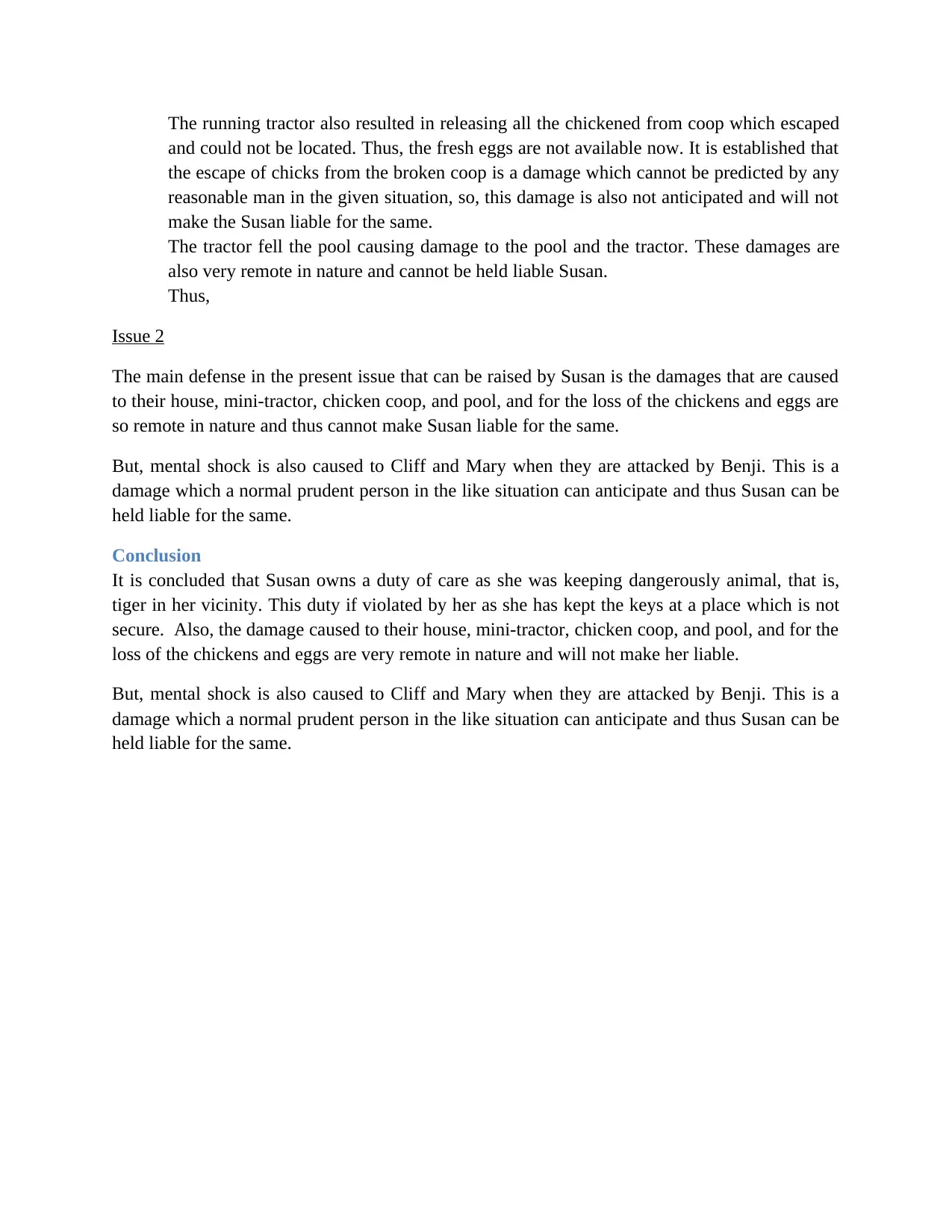
The running tractor also resulted in releasing all the chickened from coop which escaped
and could not be located. Thus, the fresh eggs are not available now. It is established that
the escape of chicks from the broken coop is a damage which cannot be predicted by any
reasonable man in the given situation, so, this damage is also not anticipated and will not
make the Susan liable for the same.
The tractor fell the pool causing damage to the pool and the tractor. These damages are
also very remote in nature and cannot be held liable Susan.
Thus,
Issue 2
The main defense in the present issue that can be raised by Susan is the damages that are caused
to their house, mini-tractor, chicken coop, and pool, and for the loss of the chickens and eggs are
so remote in nature and thus cannot make Susan liable for the same.
But, mental shock is also caused to Cliff and Mary when they are attacked by Benji. This is a
damage which a normal prudent person in the like situation can anticipate and thus Susan can be
held liable for the same.
Conclusion
It is concluded that Susan owns a duty of care as she was keeping dangerously animal, that is,
tiger in her vicinity. This duty if violated by her as she has kept the keys at a place which is not
secure. Also, the damage caused to their house, mini-tractor, chicken coop, and pool, and for the
loss of the chickens and eggs are very remote in nature and will not make her liable.
But, mental shock is also caused to Cliff and Mary when they are attacked by Benji. This is a
damage which a normal prudent person in the like situation can anticipate and thus Susan can be
held liable for the same.
and could not be located. Thus, the fresh eggs are not available now. It is established that
the escape of chicks from the broken coop is a damage which cannot be predicted by any
reasonable man in the given situation, so, this damage is also not anticipated and will not
make the Susan liable for the same.
The tractor fell the pool causing damage to the pool and the tractor. These damages are
also very remote in nature and cannot be held liable Susan.
Thus,
Issue 2
The main defense in the present issue that can be raised by Susan is the damages that are caused
to their house, mini-tractor, chicken coop, and pool, and for the loss of the chickens and eggs are
so remote in nature and thus cannot make Susan liable for the same.
But, mental shock is also caused to Cliff and Mary when they are attacked by Benji. This is a
damage which a normal prudent person in the like situation can anticipate and thus Susan can be
held liable for the same.
Conclusion
It is concluded that Susan owns a duty of care as she was keeping dangerously animal, that is,
tiger in her vicinity. This duty if violated by her as she has kept the keys at a place which is not
secure. Also, the damage caused to their house, mini-tractor, chicken coop, and pool, and for the
loss of the chickens and eggs are very remote in nature and will not make her liable.
But, mental shock is also caused to Cliff and Mary when they are attacked by Benji. This is a
damage which a normal prudent person in the like situation can anticipate and thus Susan can be
held liable for the same.
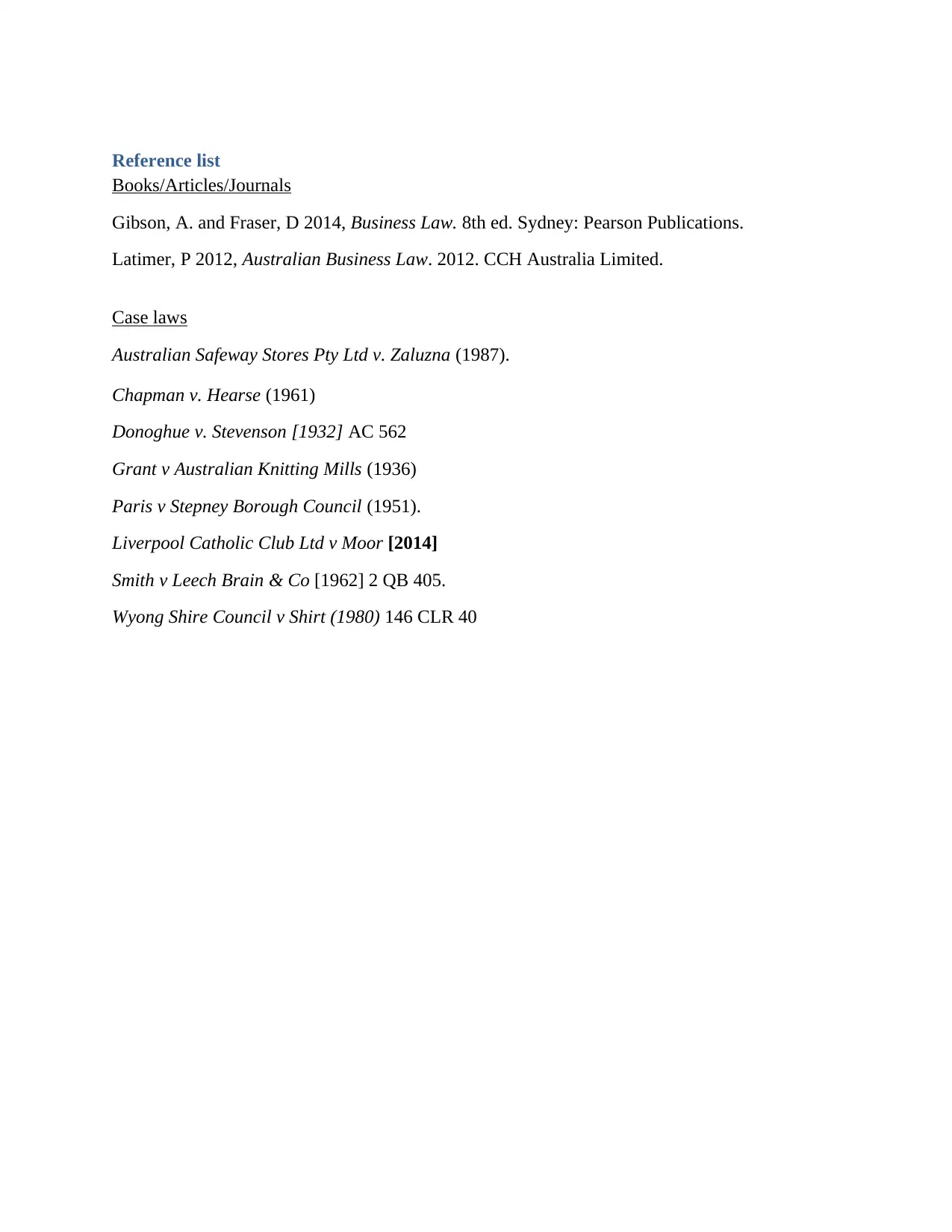
Reference list
Books/Articles/Journals
Gibson, A. and Fraser, D 2014, Business Law. 8th ed. Sydney: Pearson Publications.
Latimer, P 2012, Australian Business Law. 2012. CCH Australia Limited.
Case laws
Australian Safeway Stores Pty Ltd v. Zaluzna (1987).
Chapman v. Hearse (1961)
Donoghue v. Stevenson [1932] AC 562
Grant v Australian Knitting Mills (1936)
Paris v Stepney Borough Council (1951).
Liverpool Catholic Club Ltd v Moor [2014]
Smith v Leech Brain & Co [1962] 2 QB 405.
Wyong Shire Council v Shirt (1980) 146 CLR 40
Books/Articles/Journals
Gibson, A. and Fraser, D 2014, Business Law. 8th ed. Sydney: Pearson Publications.
Latimer, P 2012, Australian Business Law. 2012. CCH Australia Limited.
Case laws
Australian Safeway Stores Pty Ltd v. Zaluzna (1987).
Chapman v. Hearse (1961)
Donoghue v. Stevenson [1932] AC 562
Grant v Australian Knitting Mills (1936)
Paris v Stepney Borough Council (1951).
Liverpool Catholic Club Ltd v Moor [2014]
Smith v Leech Brain & Co [1962] 2 QB 405.
Wyong Shire Council v Shirt (1980) 146 CLR 40
⊘ This is a preview!⊘
Do you want full access?
Subscribe today to unlock all pages.

Trusted by 1+ million students worldwide
1 out of 6
Related Documents
Your All-in-One AI-Powered Toolkit for Academic Success.
+13062052269
info@desklib.com
Available 24*7 on WhatsApp / Email
![[object Object]](/_next/static/media/star-bottom.7253800d.svg)
Unlock your academic potential
Copyright © 2020–2025 A2Z Services. All Rights Reserved. Developed and managed by ZUCOL.





